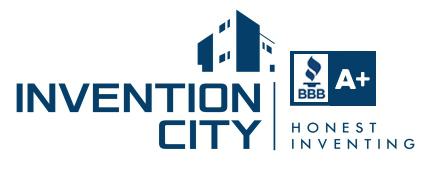
Step 5: Presenting Your Invention To A Prospective Licensee
In the interest of saving money you might be tempted to sign a Confidentiality Agreement and ship off a prototype and supporting material to a prospective licensee via FedEx. However, the best way to move the process along quickly is a face to face meeting. You can read emotions and reactions in a person’s face that will never be communicated by phone or email. You can answer questions on the spot. Your mere physical presence will cause the prospective licensee to treat your invention with more respect.
A good idea is to have a partner (or advisor) with a marketing/sales background attend the meeting with you. Your partner can speak to the marketing aspects of the invention, while you talk about the invention itself. Your partner can pick up on things you miss and help to steer the meeting in a productive direction.
A working model is a tremendous asset. I recommend to only try to obtain a licensing deal when you one. That is a little harsh, but not far from the truth. At the very least you must have decent drawings and a compelling story on why the world wants/needs your invention today.
The initial presentation is the licensee’s first chance to have a serious look at your invention. Do not expect negotiations to begin on the spot (but be prepared just in case). Ideally there should be people at the meeting representing marketing, engineering, and manufacturing. If those departments buy into your invention, you are well on your way to a deal. When you set up your meeting you can ask for those people to be in attendance.
At the beginning of the meeting, you should introduce yourself and exchange business cards. A little chitchat about the weather, travel or a recent golf game is completely appropriate. Then you should launch into your presentation.
The presentation will be a review of the information contained in your invention prospectus. Describe the invention, its features and benefits. Compare your invention to competitive and alternative products; explain why it is superior. Summarize your view of the market opportunity – how much market share (companies love that term) your invention will claim within 3-5 years and why this will happen. Review the information you learned from end user surveys. Discuss future trends that will drive people to use your invention. Talk about manufacturing costs and marketing opportunities. Show how much money can be made from the invention and how easy it will be. If you have a sample TV commercial you should show it at the end.
You can simply talk through the information conversationally or you can put the information into PowerPoint and make things more formal. If you want to use PowerPoint be sure to request an appropriate room and the necessary equipment in advance. Including your team there will probably be somewhere between 5 and 10 people in the room.
After the presentation it is time to bring out the prototype and let people try it. If you bring out the prototype in advance everyone will be distracted by it. Save the best part for the end. Showing it at the end of your presentation will allow the prototype to be better valued and understood.
Hand out the invention prospectus at the same time you present the prototype. This will give everyone in the room something to hold in their hands.
When the meeting is over you should plan on taking the prototype with you. This will reinforce the ideas that your invention is valuable and that the company does not have rights to it yet. There are reasons why you might leave it behind – for example you may already be selling the item on the Internet in limited quantities or you may already know in your heart (and your partner/advisor agrees) that a deal will take place.
A prototype is critical for further evaluation and a serious licensee may ask if it could buy one for a reasonable fee. A reasonable fee is what you might pay a third party to build one for you. Be prepared for this question and have a number in mind. It may be appropriate to have another agreement in place for reviewing the prototype. An example of a prototype review agreement can be found in the Appendix.
There are reasons why you might not want the licensee to have a prototype. Chief among these is a fear that the licensee will discover some way to knock you off by reverse engineering it, and/or that the prototype will stop functioning.
Your goal is to make the licensee want your invention. However… if you manage to sell the licensee on the idea that your invention is critical to the licensee’s future business plans, the licensee will try to find a way to commercialize your invention regardless of whether or not it signs a licensing deal with you. Confidentiality agreements and patents only go so far. A company may decide to knock you off and let the courts settle things later. There are two points here: 1) begin negotiations only if you intend to make a deal and 2) do not become arrogant and greedy even if it is true that a licensee needs your invention.
share this article: facebook